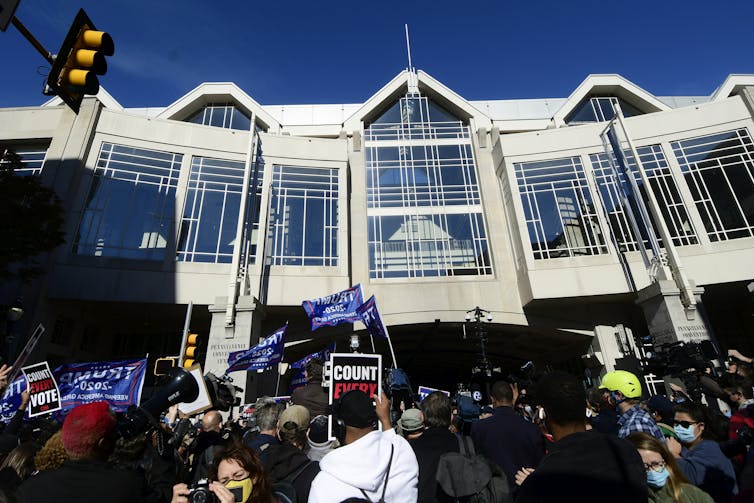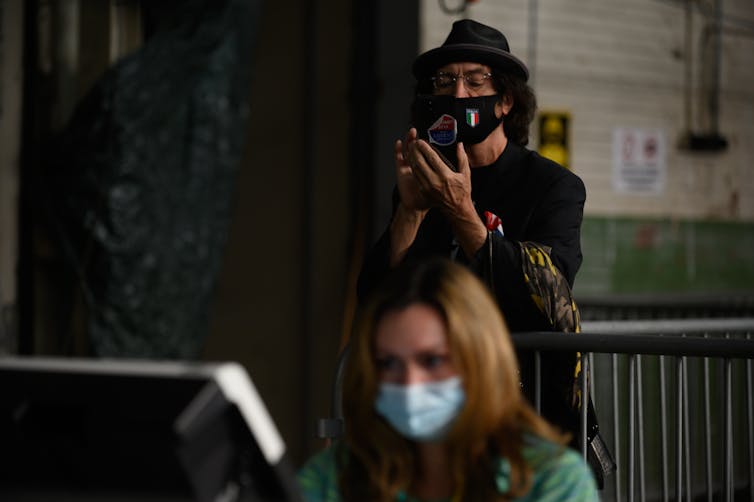How votes are counted in Pennsylvania: Changing numbers are a sign of transparency, not fraud, during an ongoing process
- Written by Kristin Kanthak, Associate Professor of Political Science, University of Pittsburgh
Last week I was grading an online exam for my students. We’re working with a new learning management system at my university and I didn’t realize my students could actually see their grades moving up and down online as I was working on their tests.
It was a mistake. Not knowing how the numbers were changing, what judgments were behind the changes, and when they’d just get to know the outcome made them frantic.
And as election officials work through the final vote tallies of the 2020 election, I imagine Americans feel similarly.
A lot of transparency with very little context is more nerve-wracking than it is helpful. This is true for exam grades as well as elections. My students can drop by my office hours if they want to understand how I graded their exams. And I hope this explainer will provide a similar context to the way we count votes in the United States.
 A Donald Trump supporter faces a crowd of Joe Biden supporters outside the central ballot counting location in Philadelphia on Thursday.
Bastiaan Slabbers/NurPhoto via Getty Images[1]
A Donald Trump supporter faces a crowd of Joe Biden supporters outside the central ballot counting location in Philadelphia on Thursday.
Bastiaan Slabbers/NurPhoto via Getty Images[1]
From grading exams to counting votes
When my students were watching me grade, they might have seen their score rising very slowly. This would make them think they were doing very poorly on the exam, because they were not getting very many points per question.
But it could be that I was just grading the most difficult questions first. Later on, when I started grading easier questions, their grades would go up fast.
Counting votes is like grading runs of easy or hard questions. This year, Democrats were far more likely to mail in their ballots[2]. Pennsylvania counts in-person ballots first, and rural areas are faster counters than urban areas. So Trump voters got the scores on the easiest questions early. If you were a Republican watching the vote count in Pennsylvania, early election returns made you feel like you were doing pretty well on the exam.
But once the urban mail-in vote started coming in, that changed. Philadelphia mail-in ballots were like a long run of tough questions. Trump’s score started declining fast.
Importantly, though, this doesn’t mean the system is “rigged.” Actually, it means the system is transparent to a fault. Usually when you take a test, you don’t see the grading happen in real time. You just get the score when the grading is done.
The key takeaway is that it doesn’t matter which questions get graded first and it doesn’t matter which votes get counted first. The end result is the same. It is just that having to watch it happen can play with your emotions.
Ballot security
Cheating on an exam is far easier than cheating in voting. Let’s go through the process to see how it works.
Step 1 (optional): Mail in your ballot
Many voters were skeptical of mailing their ballots this year, but those fears were likely mostly unfounded. Put simply, it is hard to steal your mail-in ballot. Election mail does not get thrown in with supermarket coupons. Rather, there is a special system just for mail-in ballots[3]. And like most states, Pennsylvania uses the Intelligent Mail Barcode system for ballots[4], a system that works like a Postal Service tracking number.
 A Trump campaign poll watcher films the counting of ballots at the Allegheny County elections warehouse Friday in Pittsburgh.
Jeff Swensen/Getty Images[5]
A Trump campaign poll watcher films the counting of ballots at the Allegheny County elections warehouse Friday in Pittsburgh.
Jeff Swensen/Getty Images[5]
Although voters themselves rarely see this tracking system, it is available to local canvassing boards, and the Postal Service is required to provide updates on the progression of election mail through the system. In fact, it was this system that alerted interest groups to a set of 300,000 potentially missing ballots[6] – ballots whose bar codes showed them arriving at a post office, but not leaving one.
The Postal Service assured a judge that the ballots had been safely delivered. And voters in most states, as in Pennsylvania, could check online to be sure their ballot was delivered and cast a provisional ballot if it had not. Questionable ballots are held aside, and county boards of election have seven days to determine[7] whether the vote should count.
Step 2: Verify eligibility
When you vote in person, you sign for a ballot and possibly show some identification.
This year, President Trump encouraged his supporters to vote twice – something he said later that he did as a joke. This is bad advice. It is illegal in all states[8] and can generally get you jail time. Potentially, you could lose your right to vote in future elections[9].
In fact, one of the reasons the votes in Allegheny County, Pennsylvania, took so long to count was to avoid the potential for unintentional double-voting due to an error there in ballot printing[10].
Importantly, poll observers – campaign volunteers who are looking out for their candidate’s best interests – are watching every vote as it’s processed. This is true even in Philadelphia, where Trump campaign officials sued because they claimed they were kept “in darkness” at the polling place. They defined that “darkness” as 20, rather than 6, feet away[11] from the canvassers tasked with counting the ballots[12]. Trump’s observers sued and won their 14 extra feet, but at no time were ballots being opened in secret.
Poll watchers attached to the campaigns can call out problems with a ballot. If signatures do not match, for example, a campaign’s poll watcher can challenge the ballot.
The ballot will then undergo additional scrutiny. The canvassers then make a decision about whether or not they will accept the ballot in question, and explain their decision to the poll watchers. At this point, if one of the poll watchers disagrees with the ruling the canvasser makes, he or she can make a note of the details of the ballot, including the name of the voter and the reason the vote may be incorrectly counted.
Campaigns can use these lists when they are drawing up lawsuits if they think the canvassers were counting ballots that ought to have been rejected, or rejecting ballots that ought to have been counted.
Step 3: Count the ballots
This part is straightforward. But it can take a long time because secretaries of state want exact numbers. In 2016 we knew Trump won Pennsylvania by around 44,300 votes. But the results weren’t official until officials were sure the exact number was 44,292.
Step 4 (optional): Count the ballots again
Most states have provisions for automatic recounts if the vote is very close. That margin is usually 1% or less[13] of total turnout. In Pennsylvania, the threshold is 0.05% of the vote. That’s really close, but given that turnout in Pennsylvania exceeded 6.6 million this year[14], that could be more than 33,000 votes. A recount usually isn’t likely to find enough votes to change the outcome[15].
All this is to say, watching votes get counted is like watching an exam get graded. It seems like a process that is changing over time, but it is not. The votes are already there. They will be counted. If there is fraud, it will be found. That’s why there are lawsuits.
It just may take a while, and it may be hard on your nerves in the meantime. Maybe it is best to look away until they have finished the job.
[The Conversation’s Politics + Society editors pick need-to-know stories. Sign up for Politics Weekly[16].]
References
- ^ Bastiaan Slabbers/NurPhoto via Getty Images (www.gettyimages.com)
- ^ Democrats were far more likely to mail in their ballots (www.politico.com)
- ^ special system just for mail-in ballots (about.usps.com)
- ^ Intelligent Mail Barcode system for ballots (about.usps.com)
- ^ Jeff Swensen/Getty Images (www.gettyimages.com)
- ^ alerted interest groups to a set of 300,000 potentially missing ballots (www.nbcnews.com)
- ^ county boards of election have seven days to determine (www.votespa.com)
- ^ illegal in all states (www.ncsl.org)
- ^ lose your right to vote in future elections (www.ncsl.org)
- ^ an error there in ballot printing (thehill.com)
- ^ “darkness” as 20, rather than 6, feet away (philadelphia.cbslocal.com)
- ^ canvassers tasked with counting the ballots (www.eac.gov)
- ^ 1% or less (www.ncsl.org)
- ^ Pennsylvania exceeded 6.6 million this year (www.sfchronicle.com)
- ^ usually isn’t likely to find enough votes to change the outcome (fivethirtyeight.com)
- ^ Sign up for Politics Weekly (theconversation.com)
Authors: Kristin Kanthak, Associate Professor of Political Science, University of Pittsburgh

